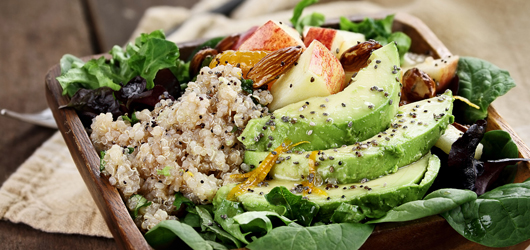
By Robert Whitten, MD, and Mary Kemper
If you suffer with chronic pain, some changes in your diet could improve your health.
Foods can either raise or lower the levels of inflammation in the body. Eating fewer pro-inflammatory foods and/or consuming more anti-inflammatory foods can be part of an overall strategy for coping with back, neck or joint pain. This pain-free – and delicious! – lifestyle change can set you on a path toward your optimum health.
The strategy follows the science of nutrition, providing the body with important nutrients in a manner that reduces the insult of diet-triggered inflammation.
Anti-inflammatory diets continue to gain popularity, as research demonstrates their benefits again and again. Breakthroughs have evolved in the science of how to reduce low-level chronic inflammation in the tissues. Anti-inflammatory nutrition offers not only a natural remedy for pain control but often brings other health benefits as well, such as improved insulin utilization and cholesterol control. Healthy eating can be a step on the path toward prevention or recovery from a cycle of chronic pain.
Chronic pain is tied to inflammation, which is part of the body’s first defense in the immune response. With injury or insult, a complex dance is initiated in the body, utilizing many systems at the cellular level (antibodies, white blood cells, platelets, fibrin), that interact over time with larger, more integrated systems (connective tissues, muscles, joints).
Cellular inflammation can be a silent threat. We may feel nothing when it begins. But once started, some aspects are maintained indefinitely, in a poorly understood interaction between what happens in our cells and how that process is reflected in our muscles, joints and blood vessels. We see the consequences of inflammation in scar tissue buildup, decreased flexibility, the acceleration of joint degeneration and hardening of the arteries. We see its interaction with other chronic diseases, such as obesity, diabetes, or even neurological disease.
For most patients with chronic back or neck pain, more traditional treatment strategies can include lifestyle changes, physical therapy, nerve blocks or injections, and medications.
An often forgotten natural strategy can be the concept that food is medicine. Anti-inflammatory diets can offer nutrition without the unpleasant side effects of medications (e.g., drowsiness, depression, constipation, etc.). Over time, cellular inflammation can be better managed. Many patients have reported positive changes, measured over weeks or months, after adopting anti-inflammation strategies that include:
- eating whole foods (those with little or no processing)
- reducing or eliminating dairy foods (milk, butter, cheese, yogurt)
- following a Mediterranean diet
- adopting a vegan or vegetarian (plant-based) diet
Known inflammatory culprits include sugar, alcohol, dairy products, gluten (e.g., muffins, bagels, pasta), processed foods (e.g., French fries), foods prepared at high temperatures (e.g., fried, blackened, barbequed), and some nightshade vegetables (e.g. potatoes, tomatoes, eggplant). Choosing to reduce or eliminate some of these culprits can be beneficial.
In a small subset of patients, the results have been dramatic. A simple — but not necessarily easy — 30-day, dairy-free trial can sharply reduce joint or back pain in sensitive patients. By eliminating dairy, you eliminate the milk protein called casein. Casein can trigger the body’s release of histamine but has other effects in our bodies that are not clearly understood.
One strong advocate of a plant-based diet, the nutritional biochemist Dr. T. Colin Campbell, reported the effects of casein as a carcinogen in The China Study.
Perhaps the best advice: pack your plate with anti-inflammatory foods. You can get the carbohydrates, proteins, and fats your body needs from fresh fruits and vegetables and whole grains. Strive for more plant-based foods, more monounsaturated fats (from foods like olive oil, nuts, and avocado), and less animal-based protein. Think of this approach as “leaning vegan” — reducing meat and dairy to once a week or several times a month.
Another view of this kind of diet can be found at the website of integrative medicine leader Dr. Andrew Weil. A nice summary would be this: Fill your plate with mostly fruits and vegetables, some whole grains, healthy protein and fats; season with spices (e.g., turmeric, ginger) and herbs that are known inflammation fighters. Treats include a glass of red wine with dark chocolate.
An anti-inflammatory diet is a way of living that can bring you more energy and less pain, while allowing you to feel in charge of your health and well-being. When we eat whole foods, we feel better and can do more for ourselves and the planet. There are many anti-inflammatory options. Consider making some changes and — with your doctor — see which one might be best for you.
Robert Whitten, MD, is a physical medicine & rehabilitation specialist with Mayfield Brain & Spine. Mary Kemper is a TriYoga Instructor and Medical Editor for Mayfield and GliaMedia.